新闻语言特点
- 格式:docx
- 大小:28.35 KB
- 文档页数:11
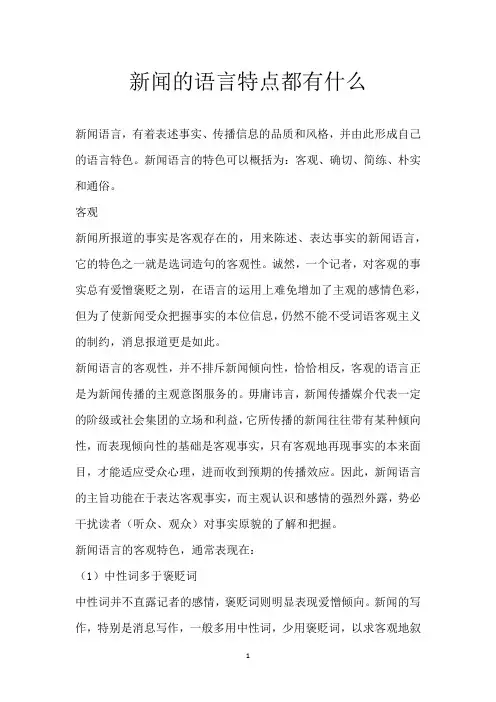
新闻的语言特点都有什么新闻语言,有着表述事实、传播信息的品质和风格,并由此形成自己的语言特色。
新闻语言的特色可以概括为:客观、确切、简练、朴实和通俗。
客观新闻所报道的事实是客观存在的,用来陈述、表达事实的新闻语言,它的特色之一就是选词造句的客观性。
诚然,一个记者,对客观的事实总有爱憎褒贬之别,在语言的运用上难免增加了主观的感情色彩,但为了使新闻受众把握事实的本位信息,仍然不能不受词语客观主义的制约,消息报道更是如此。
新闻语言的客观性,并不排斥新闻倾向性,恰恰相反,客观的语言正是为新闻传播的主观意图服务的。
毋庸讳言,新闻传播媒介代表一定的阶级或社会集团的立场和利益,它所传播的新闻往往带有某种倾向性,而表现倾向性的基础是客观事实,只有客观地再现事实的本来面目,才能适应受众心理,进而收到预期的传播效应。
因此,新闻语言的主旨功能在于表达客观事实,而主观认识和感情的强烈外露,势必干扰读者(听众、观众)对事实原貌的了解和把握。
新闻语言的客观特色,通常表现在:(1)中性词多于褒贬词中性词并不直露记者的感情,褒贬词则明显表现爱憎倾向。
新闻的写作,特别是消息写作,一般多用中性词,少用褒贬词,以求客观地叙述事实,并通过事实的报道去影响受众。
请看下面这条消息的语言运用:新华社上海1957年2月12日电这几天上海街头积雪不化,春寒料峭,最低温度下降到摄氏零下7.4度,上海人遇到了有气象记载的80多年来罕见的严寒。
10日和11日,这里出现了晴天下雪的现象。
晴日高照,雪花在阳光下飞舞,行人纷纷驻足仰望这个瑰丽的奇景。
“前天一夜风雪,昨夜八百童尸。
”这是诗人臧克家1947年2月在上海写下的诗篇《生命的零度》中开头的两句。
这几天要比10年前冷得多,但据上海市民政局调查,到目前并没有冻死的人。
民政局已布置各区加强对生活困难的居民特别是孤苦无依的老人的救济工作。
为了避免寒冷影响儿童的健康,上海市教育局已将全市幼儿园的开学日期延至18日。
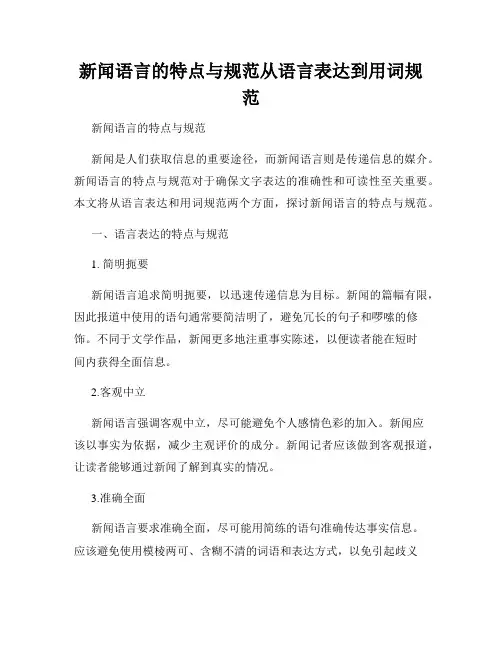
新闻语言的特点与规范从语言表达到用词规范新闻语言的特点与规范新闻是人们获取信息的重要途径,而新闻语言则是传递信息的媒介。
新闻语言的特点与规范对于确保文字表达的准确性和可读性至关重要。
本文将从语言表达和用词规范两个方面,探讨新闻语言的特点与规范。
一、语言表达的特点与规范1. 简明扼要新闻语言追求简明扼要,以迅速传递信息为目标。
新闻的篇幅有限,因此报道中使用的语句通常要简洁明了,避免冗长的句子和啰嗦的修饰。
不同于文学作品,新闻更多地注重事实陈述,以便读者能在短时间内获得全面信息。
2.客观中立新闻语言强调客观中立,尽可能避免个人感情色彩的加入。
新闻应该以事实为依据,减少主观评价的成分。
新闻记者应该做到客观报道,让读者能够通过新闻了解到真实的情况。
3.准确全面新闻语言要求准确全面,尽可能用简练的语句准确传达事实信息。
应该避免使用模棱两可、含糊不清的词语和表达方式,以免引起歧义和误导。
同时,新闻语言需要囊括全面的信息,确保读者能够获取全部重要的内容,并了解相关背景和细节。
二、用词规范的特点与要求1.使用常见词汇新闻语言常使用常见词汇,避免太过专业化或难以理解的术语。
这样可以让更多的读者理解新闻内容,提高新闻的可读性。
2.避免主观色彩和情感词汇新闻语言应避免使用带有主观色彩和情感色彩的词汇。
例如,使用“认为”代替“觉得”,使用“表示”代替“感受”,以减少个人情感因素对新闻报道的影响。
3.使用准确严谨的词汇在选择词汇时,新闻语言应尽量采用准确严谨的词汇,以确保传递的信息准确无误。
使用不恰当的词汇可能导致误解或产生不良影响。
综上所述,新闻语言在语言表达和用词规范上有其独特的特点与规范。
它要求简明扼要、客观中立、准确全面的语言表达,以及使用常见词汇、避免主观色彩和情感词汇、使用准确严谨的词汇的用词规范。
这些特点与规范确保了新闻信息的准确性、可读性和可信度,使人们能够获得更多更好的新闻信息。
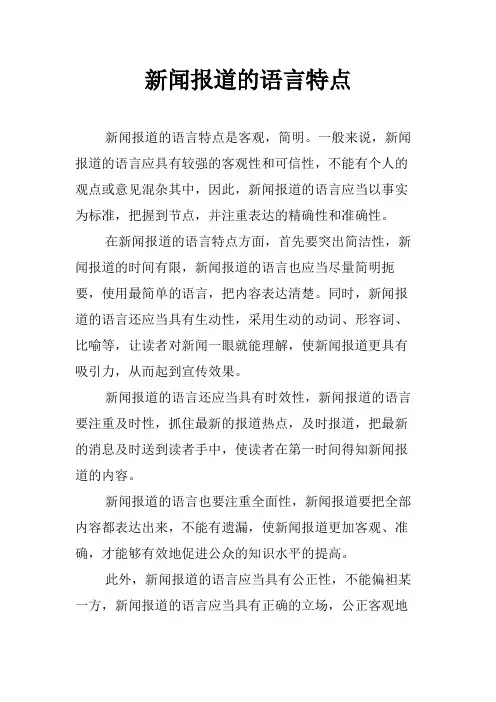
新闻报道的语言特点
新闻报道的语言特点是客观,简明。
一般来说,新闻报道的语言应具有较强的客观性和可信性,不能有个人的观点或意见混杂其中,因此,新闻报道的语言应当以事实为标准,把握到节点,并注重表达的精确性和准确性。
在新闻报道的语言特点方面,首先要突出简洁性,新闻报道的时间有限,新闻报道的语言也应当尽量简明扼要,使用最简单的语言,把内容表达清楚。
同时,新闻报道的语言还应当具有生动性,采用生动的动词、形容词、比喻等,让读者对新闻一眼就能理解,使新闻报道更具有吸引力,从而起到宣传效果。
新闻报道的语言还应当具有时效性,新闻报道的语言要注重及时性,抓住最新的报道热点,及时报道,把最新的消息及时送到读者手中,使读者在第一时间得知新闻报道的内容。
新闻报道的语言也要注重全面性,新闻报道要把全部内容都表达出来,不能有遗漏,使新闻报道更加客观、准确,才能够有效地促进公众的知识水平的提高。
此外,新闻报道的语言应当具有公正性,不能偏袒某一方,新闻报道的语言应当具有正确的立场,公正客观地
表达事实,并尊重不同的意见,使新闻报道的内容更加客观、准确。
新闻报道的语言应当具有规范性,新闻报道应遵循一定的语言规范,如拼写、标点、语法等,使新闻报道的语言更加规范,更易于理解。
总之,新闻报道的语言应当具有客观、简明、时效性、全面性、公正性和规范性特点,才能够有效地宣传信息,满足读者的需求,提升新闻报道的质量。
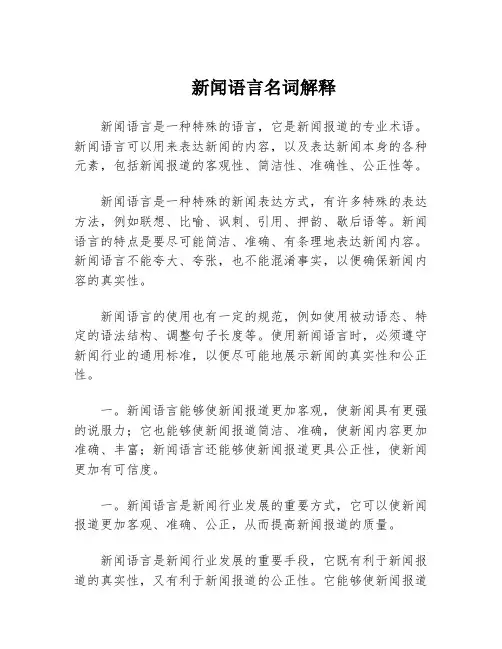
新闻语言名词解释
新闻语言是一种特殊的语言,它是新闻报道的专业术语。
新闻语言可以用来表达新闻的内容,以及表达新闻本身的各种元素,包括新闻报道的客观性、简洁性、准确性、公正性等。
新闻语言是一种特殊的新闻表达方式,有许多特殊的表达方法,例如联想、比喻、讽刺、引用、押韵、歇后语等。
新闻语言的特点是要尽可能简洁、准确、有条理地表达新闻内容。
新闻语言不能夸大、夸张,也不能混淆事实,以便确保新闻内容的真实性。
新闻语言的使用也有一定的规范,例如使用被动语态、特定的语法结构、调整句子长度等。
使用新闻语言时,必须遵守新闻行业的通用标准,以便尽可能地展示新闻的真实性和公正性。
一。
新闻语言能够使新闻报道更加客观,使新闻具有更强的说服力;它也能够使新闻报道简洁、准确,使新闻内容更加准确、丰富;新闻语言还能够使新闻报道更具公正性,使新闻更加有可信度。
一。
新闻语言是新闻行业发展的重要方式,它可以使新闻报道更加客观、准确、公正,从而提高新闻报道的质量。
新闻语言是新闻行业发展的重要手段,它既有利于新闻报道的真实性,又有利于新闻报道的公正性。
它能够使新闻报道
更加准确、客观、公正,从而有助于提高新闻报道的质量,同时也能够使新闻报道更具有可信度和可读性,让更多的人能够更好地了解新闻信息。
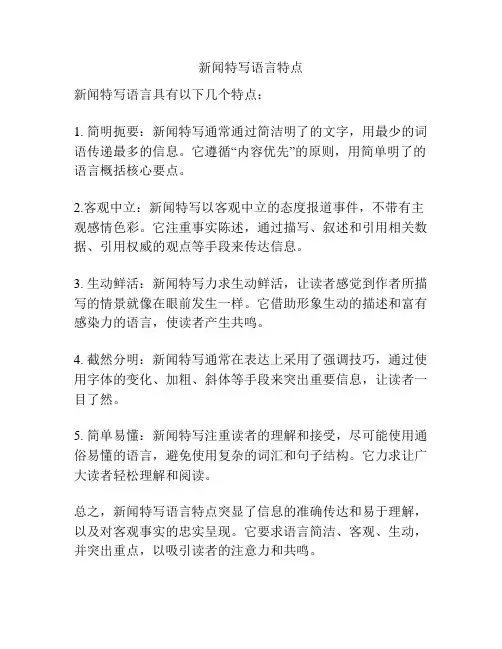
新闻特写语言特点
新闻特写语言具有以下几个特点:
1. 简明扼要:新闻特写通常通过简洁明了的文字,用最少的词语传递最多的信息。
它遵循“内容优先”的原则,用简单明了的语言概括核心要点。
2.客观中立:新闻特写以客观中立的态度报道事件,不带有主观感情色彩。
它注重事实陈述,通过描写、叙述和引用相关数据、引用权威的观点等手段来传达信息。
3. 生动鲜活:新闻特写力求生动鲜活,让读者感觉到作者所描写的情景就像在眼前发生一样。
它借助形象生动的描述和富有感染力的语言,使读者产生共鸣。
4. 截然分明:新闻特写通常在表达上采用了强调技巧,通过使用字体的变化、加粗、斜体等手段来突出重要信息,让读者一目了然。
5. 简单易懂:新闻特写注重读者的理解和接受,尽可能使用通俗易懂的语言,避免使用复杂的词汇和句子结构。
它力求让广大读者轻松理解和阅读。
总之,新闻特写语言特点突显了信息的准确传达和易于理解,以及对客观事实的忠实呈现。
它要求语言简洁、客观、生动,并突出重点,以吸引读者的注意力和共鸣。
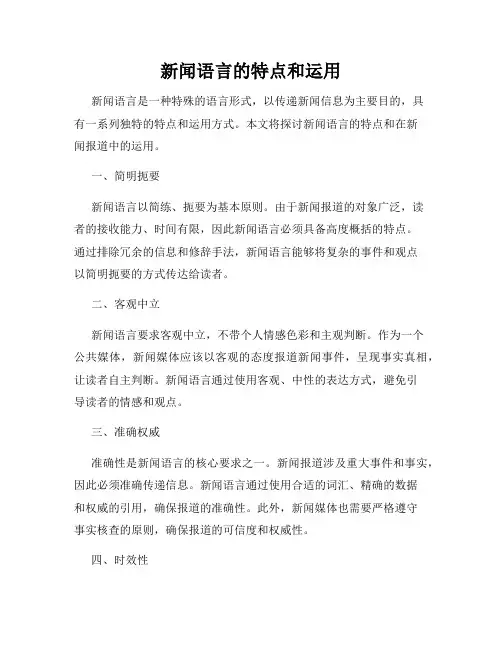
新闻语言的特点和运用新闻语言是一种特殊的语言形式,以传递新闻信息为主要目的,具有一系列独特的特点和运用方式。
本文将探讨新闻语言的特点和在新闻报道中的运用。
一、简明扼要新闻语言以简练、扼要为基本原则。
由于新闻报道的对象广泛,读者的接收能力、时间有限,因此新闻语言必须具备高度概括的特点。
通过排除冗余的信息和修辞手法,新闻语言能够将复杂的事件和观点以简明扼要的方式传达给读者。
二、客观中立新闻语言要求客观中立,不带个人情感色彩和主观判断。
作为一个公共媒体,新闻媒体应该以客观的态度报道新闻事件,呈现事实真相,让读者自主判断。
新闻语言通过使用客观、中性的表达方式,避免引导读者的情感和观点。
三、准确权威准确性是新闻语言的核心要求之一。
新闻报道涉及重大事件和事实,因此必须准确传递信息。
新闻语言通过使用合适的词汇、精确的数据和权威的引用,确保报道的准确性。
此外,新闻媒体也需要严格遵守事实核查的原则,确保报道的可信度和权威性。
四、时效性新闻语言追求时效性,及时报道事件发生的情况。
当今的新闻媒体受到快速传播的互联网影响,要求新闻报道更快速、更及时。
新闻语言通过使用紧迫感强的词汇、简短的句子和图像化的表达方式,以吸引读者的注意力,传递信息的时效性。
五、多样性和灵活性新闻语言的多样性和灵活性使得新闻报道能够适应各种场景和媒介。
新闻语言可以根据报道对象的性质和目标读者的需求,调整表达方式和方式。
例如,新闻报道的形式可以是新闻报道、特写报道、专题报道等。
这种多样性使得新闻媒体能够更好地满足读者的需求。
总之,新闻语言具有简明扼要、客观中立、准确权威、时效性、多样性和灵活性的特点。
这些特点在新闻报道中起到至关重要的作用,能够确保信息的传递和理解。
新闻媒体通过运用新闻语言的特点,能够更好地与读者沟通,传达信息,推动社会进步。
新闻的语言特征
1.新闻语言简明晓畅,通俗易懂,采用常用的词语语言,尽量避免生僻词,专业术语和难懂的措辞。
2.新闻语言的用词清新简洁,内容简短明了,尽量简洁,语言简练。
标点符号使用恰当,语法正确,结构严谨。
3.新闻语言的格式规范,版面清晰,标题鲜明突出。
新闻报道句式多变,常见的句式有倒装句,掉头句,借题发挥等,并且要注意吸引读者的眼球。
4.新闻语言的真实性强,报道的忠实于事实,尽量准确,不歪曲事实,不随意投机取巧。
5.新闻语言的客观性强,不带有明显的主观性,不宣传个人观点,不给读者带来任何的猜疑和质疑。
6.新闻语言的时效性强,根据时下的社会热点,时事报道和时事评论,贴近社会热点,反映社会风向。
7.新闻语言的多样性,针对不同类型的新闻报道采用不同的语言特点和风格,如新闻报道、专题报道、评论和专栏等使用不同的语言形式。
8.新闻语言的应变能力,对于突发事件和紧急情况能够迅速反应,采用紧凑的语言,向读者传递最新的信息和趋势。
9.新闻语言的情感调控能力,通过语言情感的调控,增强报道
的感染力和说服力,促进读者的共鸣。
10.新闻语言的传播性强,新闻作为一种大众传播工具,新闻
语言需要通过简单易懂的语言传递信息,在快速传递的过程中,促进新闻的传播和贯彻。
新闻的语言特点
1. 简洁明了:新闻语言不会过多使用文学或诗歌式的华丽词汇,而是尽可能简单明了地传达信息,并且会把复杂的事件或问题简化为易于理解和表述的形式。
2. 直截了当:新闻语言使用直白、简单的句式来表达事件或新闻的主要内容,避免使用委婉或复杂的表达方式,以确保读者能够准确、迅速地理解新闻的核心信息。
3. 客观中立:新闻的语言应当尽量客观中立,不会夹带个人观点或情感色彩,在报道事件时,应当尽量避免主观价值判断或偏见,仅仅提供大量事实和数据,让读者自行评估和形成自己的观点。
4. 实事求是:新闻语言应该以准确、全面、真实的方法来表述事实,严谨遵守事实的真相,避免误导和不实传言。
5. 时效性强:新闻的语言应该紧贴新闻事件发生的现场,以最快、最直接的方式传递信息,因此,新闻语言通常会在语文上追求简洁、明了、生动,并且往往具有一定的感染力和话题性。
新闻作品的语言特点
1. 新闻作品的语言要准确呀!就像射击要直击靶心一样,不能有丝毫的偏差。
比如报道一场比赛的结果,总不能把赢家给说错了吧!准确的语言才能让读者信任。
2. 新闻语言得简洁明了呢!不能啰嗦得让人不耐烦,得像一把利剑一样,直接切中要害。
比如说报道一个突发事件,决不能长篇大论让人抓不住重点。
3. 新闻作品的语言要有生动性呀!不然怎么吸引人去看呢,要像一场精彩的戏剧一样。
比如描述一个火灾现场,让读者仿佛能身临其境感受到那种紧张和危险。
4. 新闻语言还得客观公正呀!不能带有自己的偏见,就像法官判案一样公平。
比如说报道一个争议事件,不能偏袒任何一方。
5. 新闻作品的语言要有感染力呢!要能带动读者的情绪,或兴奋,或悲伤。
像报道一个感人的故事,要让读者也忍不住落泪。
6. 新闻语言得有及时性哦!不能等事情都过了好久才报道,那还有什么意义呢?就如同刚出炉的面包,新鲜才有吸引力。
7. 新闻作品的语言还要有权威性呢!让读者觉得可靠,能信赖。
比如说报道一些重要政策,必须准确传达官方声音。
总之,新闻作品的语言特点太重要啦,直接影响到新闻的质量和影响力!。
新闻联播的语言特点与写作风格新闻联播是一档重要的新闻报道节目,旨在为广大观众传递最新的国内外消息。
作为新闻媒体的代表,新闻联播在语言特点和写作风格上具有独特的特点。
本文将从多个方面来探讨新闻联播的语言特点与写作风格。
第一,新闻联播的语言特点之一是客观性。
新闻联播的报道以客观、中立的态度为基础,对事件和事实进行客观、全面地报道。
新闻联播在报道中避免使用主观情感色彩的词语,而是通过客观的描述来为观众呈现事实。
这种客观性的语言特点有助于保持新闻联播的公正性和客观性。
第二,新闻联播的语言特点之二是简明扼要。
由于新闻联播是一档时间有限的节目,因此在写作风格上,新闻联播倾向于使用简短、精准的语言来表达要点。
新闻联播的报道往往以简明扼要的方式传达最新的新闻消息,避免冗长和拖沓的语句,以便于观众快速获取信息。
第三,新闻联播的语言特点之三是准确性。
作为新闻媒体的代表,新闻联播在报道中要求准确传递信息,杜绝虚假和不实的消息。
在写作风格上,新闻联播使用准确的词语和表达方式,确保信息的准确传达给观众。
准确性是新闻联播的重要特点之一,它有助于维护良好的媒体形象,并赢得观众的信任。
第四,新闻联播的语言特点之四是严谨性。
新闻联播在报道中追求严谨和严密的写作风格。
它强调对事实的准确获取与分析,并通过对各个方面的多方面报道和对比,以确保报道的全面性和客观性。
严谨性的语言特点有助于确保新闻联播报道的权威性和可信度。
第五,新闻联播的语言特点之五是正式性。
由于新闻联播是一档正式的节目,它在语言风格上追求正式性和庄重性。
新闻联播的语言表达避免使用不恰当的俚语和口语,而是使用正式的词汇和表达方式,以确保信息传递的严肃性和权威性。
总结起来,新闻联播的语言特点与写作风格是客观、简明扼要、准确、严谨和正式。
这些特点有助于确保新闻联播的报道具有公正、客观、准确和权威的性质。
随着社会的发展和观众需求的变化,新闻联播的语言特点和写作风格也在不断调整和改变,以适应新的需求和要求。
摘要现在,有很多用英语报道的新闻,但是国际上已经约定熟成一种通用的报道新闻的语言模式,那就是新闻英语。
然而,从某种程度上说,新闻中使用的英语和人们日常生活中使用的英语是不一样的。
本文就浅析新闻英语语言特征。
关键词:新闻英语特征词汇AbstractToday, there are many media reporting news in English, but what they used is a common mode of English news internationally, that is, news English this particular style. However, the language used in English newspapers is quite different from general English to some extent.Key words: News English Features WordsContentsAbstract (3)1.Introduction (5)2.Understanding the news english (5)2.1 Definitions of news english (6)2.2Natures of news english (6)3.Lexical features of news english (6)3.1 Short words (7)3.2 Abbreviations (8)3.2.1 Acronyms (8)3.2.2 Clippings (8)3.3 Frequent use of new words (9)3.3.1 Sense-shift (9)3.3.2 Part of Speech Shift (10)3.4 Borrowed words (10)3.4.1 Loan words (10)3.4.2 Proper names of persons or places (11)3.4.3 Slang (11)Bibliography (12)An Analysis of the LinguisticFeatures of News English1IntroductionWith increasing international exchange between China and the other parts of the world, language study is becoming an indispensable part in daily life. Especially nowadays, as English has increasingly come into world-wide use, there has arisen an acute need for more information on the language and the ways in which it is used. Reading English newspapers opens a special window for people to be dipped into new things and stories that come forward everyday, and give people the opportunity of picking up language. They are the primary mass medium from which people receive new information. Newspapers have a rich mix of content —news, advice, comics, opinions, puzzles and data. Some people go right for the stock market tables, others to sports or a favorite column ist. Unlike radio and television, people don’t have to wait for what they want. Newspapers are important in people’s lives, and as a medium they adapt to changing lifestyles.Today, there are many media reporting news in English, but what they used is a common mode of English news internationally, that is, news English this particular style. However, the language used in English newspapers is quite different from general English to some extent. It is a common occurrence that people are often confused with the wide-range new expressions and have no idea about its unique structure and the use of rhetorical devices and so on. Then how can people cope with such linguistic problems to read the English news effectively and understand it accurately. How can journalists write an informative news story? The paper is to give an analysis of the basic linguistic features — lexical features and grammatical features of English news. The main purpose of this paper is to improve reader’s ability to read English news. It is hoped that it will be particularly useful to those who have strong interests in reading English news.2Understanding of News EnglishLanguage is changing constantly, especially in today’s world, the advancement of science and technology, the development of society and civilization, and the complication of our life bring into a lot of new expressions, which frequently appear in news English. Through reading English news, people can not only know the things happening around them but also acquire some knowledge about English, therefore, reading English news is by all means an effective way to learn modern English.Generally speaking, news English belongs to general English, i.e. the main part of Standard English. As an applied language, it has formed unique features which differ greatly from general English.2.1 Definition of News EnglishTo figure out the linguistic features of news English, it is necessary to know what news is. The word “News” derives from Greece. In American reporter Joest’s opinions, the word “News” comes from the word “New”. It is clear that freshness is one of the most essential features of news.Most of the traditional dictionaries share the view that news refers to the report of current events in a newspaper or on radio and television. Here it summarizes two major aspects of the essence of news, that is, real time and by means of mass media, i.e. newspapers, magazines, radio and television. They consistently skip a thriving industry in mass communication: the on-line news, which should not be ignored in the study.News English belongs to news, it is the news that was written in English. So we know news English very well.2.2 Natures of News EnglishFrom the definitions of news English mentioned, it is not difficult for people to understand the features of news English. English is the general language in the world, so news English is very important in the world. News English is the important news for people to know the world. According to Zheng Baowei (2003), news has four distinctive natures, so the news English also has the four distinctive natures.First, news English must be true. News is the report of facts which are the basis of news. Without facts there would be no news. Second, news English must be new. It is said that the word “news” comes the word “new”. News English is a kind of information conveyed to the people, but it is not the common information; instead it is about the things in its newest state. Third, news English must be timely. If the true and new facts were not released timely, news English would become old and valueless. Therefore, the mass media must disclose the facts to the masses as soon as possible. Last, news English must be made known to the public. In the modern society, the news English media ate the most important and most-frequently-used channel for people to get to know the outside world. Everyday newspapers, radio broadcast and TV continuously release a large amount of news English, and all the news English is open to the public.Based on the above definition and natures, people should pay attention to the words and sentences in news English. News English is the applied language, which is different from the ordinary English, it has a distinctive style of language forms and stylistic features.3Lexical Features of News EnglishThis part will focus mainly on the lexical features of news English. News English has its main task of getting across the message and informing its readers. The language ituses is, accordingly, different from either the literary language of novels and essays or the persuasive language of advising. News English, therefore, has its own distinctive features. Only after having picked up the basic characteristics of news language, can people have a good command of skills or ways to read news English.3.1 Short WordsOn the one hand, economy in style is a must in English news; on the other, newspapers are written to be read hurriedly by persons of all walks of life. As a result, short words are called for to meet the needs of this kind. In some literature concerned with English news, short words are also named monosyllabic words or midget words. Midget words, the short and dynamic expressions, are preferred by journalists for their rich meaning and concise wording. The high-frequent midge words can be classified into three groups.First, short words predominate over longer ones. As discussed above, readers show little patience to redundant words. Also they bear a resistance to complicated and long words, which, on the other hand, would be the second choice for news editors if other words are available to convey similar meaning while occupying a bit less space. Now take a look at the following examples which are taken from the American popular magazine, Time.“AT&T also upped the ante for its CEO, Robert Allen.” (Time, M ar.1, 1993, P49) “Tit-for-Tat strikes highlight the depth of Israeli-Palestinian strife.” (Time)The underlined words in the sample sentences above, “up” and “strife” are the synonyms of “increase” and “conflict” respectively. Obviously, they take less spa ce in print-out and express the meaning thoroughly. Even though the word “up” used here as a verb is to some extent informal, it does not really contradict the essence of news stated “diversity”, that is, it is “the mix of the serious and the less serious.”Second, single words replace phrases. Some midget words are so frequently appearing in English news that they have formed the specific contextual meaning differentiated from their common usages and even some words come to be exclusively used in news repo rting. A typical example is the word “woo” as used in the following news taken from BBC broadcast. “Arroyo set to woo China on trade: Philippines leader Gloria Arroyo aims to strengthen economic ties with China during a visit to Beijing.” () Here the word “woo” takes the place of the phrase “seek to win”, which is widely used in the genres other than journalistic writing. Also, the replacement sometimes causes difficulties in news-reading if the audience is not sufficiently acquainted with news English. For example, Chinese readers, who know about the basic knowledge of British parties, would still be confused by the following news: “A Tory candidate says even a long-time Labor seat in a Notts former coalfield is a possible target” (), because “Tory”, as the substitution for “the British Conservative Party”, is quite new to them.Last, propositions and particles substitute for phrases or clauses. Propositions are meaningful in their own right, especially for the ones that overlap with adverbs or particles. Grammatically these propositions can function as phrases or clauses in certain contexts. The word class thus is not supposed to be ignored in news English.Linguists H.L. Mencken and Simeon Potter once pointed out that excessive use of short words is one of the most distinctive characteristics of English news. The following short words often appear in English news:aim — purpose, object, intention (目的,目标,意图)ban — prohibition ,restraint, interdict (禁止,遏止,制止)bid — offer, attempt, endeavor, proposal (出价,试图,努力,建议)cut — reduction, shortening, curtailment, abridgement (减少,减短,缩减,节略) meet — meeting, assembly, conference, convention (会议,集会,会谈,大会)key — very important (关键的)now — at the present time soon — in the neat future3.2 AbbreviationsAs discussed above, simplification is the universal tendency in journalistic writing, which justifies the wide-spread contractions in English news. Here are two main devices of contractions commonly used in journalistic style: acronym and clipping. 3.2.1 AcronymsAcronym is “a word formed from the initial letters of a name, such as WAC for Women's Army Corps, or by combining initial letters or parts of a series of words, such as radar for radio detecting and rang ing.”()The following part is going to take the behind-the-scene’s look at the secret of acronyms applied to journalism since shortening might cause unease and confusion among readers even though they save a bit newspaper or magazine space.Most of technical and medical terms are in the form of acronyms in news reporting on the ground that the original forms of these terms are usually too complicated for laypersons while the acronyms are much simplified and suited for mass audience. Readers are in fact more comfortable with such words as “DNA”,“LASER” than their original terms of “genetics deoxyribonucleic acid” and “light amplification by stimulated emission of radiation”.Here are other examples:CPC — Communist Party of China (中国共产党)IMF — International Monetary Fund (国际货币基金组织)WHO — World Health Organization (世界卫生组织)PC — personal computer (个人电脑)DINKS — double income, no kids (丁克族)3.2.2 ClippingsAnother common way of making a word is to shorten a longer word by cutting a part of the original and using what remains instead. This is called clipping or shortening. In modern times, people tend to be economical in writing and speech to keep up with the tempo of new life style. To save time one is likely to clip words that are frequently used. There are six types of clipping:Front clipping: the shortening occurs at the beginning of the word, like bus (fromomnibus).Back clipping: the shortening occurs at the end of the word, e.g. photo (from photograph).Front and back clipping: the shortening occurs at both ends of the word, a typical example of which is flu (from influenza).Middle clipping: the shortening occurs at the middle of the word, for example, motel (from motor hotel).Phrase clipping: the shortening occurs in phrase, like pub (from public house), pop (from popular music)Free clipping: the shortening is not strictly in line with a certain rule, such as bike (from bicycle), Aussie (from Australian). (Feng Shimei, 2002:101-102)Because they are much frequently appearing in news reporting, readers do not feel uncomfortable with the clipped words at all and some of them are so popular that readers would ignore or even forget their original forms.3.3Frequent Use of New WordsWhat are new words? This is definitely a hard question which can never be answered satisfactorily, because there is no certain yardstick to measure which words are new. As far as the new words contained in English news are concerned, they are any words, phrases or meanings that come into popular use in English or enjoy a vogue for the appearance of certain social phenomenon, advent of a new technology and the other new phenomena.Nowadays, new words are entering the English language at an ever-increasing speed. People live in an age of knowledge explosion. With the development of science and technology in the modern society, high-tech products no longer belong exclusively to the science laboratories, but become part of people’s life. It has been gradually found that it is hard to express those new things and ideas with the existing words. In this case, new expressions have been created. The mass media take the responsibility to inform the audiences about the recent development of the technologies that have much impact on them or in which they may show great interest. That is why such news reports are crammed with the words and phrases created to describe new scientific discoveries or inventions or the associated concepts. It is well known that language is a part of culture and plays a very important role in it. Language is influenced and shaped by culture; it reflects culture. In general, new words or expressions ate formed by some lexical devices such as derivation, compounding, initialism or acronym and blending. Apart from that, some new words are from sense-shift of changing the old meaning into new and special one. With the popularity of new words through mass media, some of them have been accepted and collected into dictionaries.3.3.1 Sense-shiftBy sense-shift are meant words which extend new meanings from their original meanings. This is common in English news. For instance, “roommate” shifts from “aperson with whom one shares a room or rooms” to “cohabitant”; the original meaning of the word “gay” is “happy”, but now it is used to refer “homosexual” or “homosexuality”. The meaning has changed completely. All in all, the original meanings of these words have been enlarged or extended, which enrich the news language to a large degree. This is also a distinctive characteristic of modern English.3.3.2 Part of Speech ShiftIn English news, it is a common linguistic phenomenon that shifting the part of speech of a word forms a new meaning. A noun can change into a verb, with an adjective of an adverb can be a verb or a verb changes into a noun, etc. The shifting may not only produce new meanings, but also make sentences simple, novel and vivid. Take the noun “mothball” for example. It means a marble-sized ball, originally of camphor, stored with clothes to repel moths, while in these days, it can be a verb or an adjective, meaning “to remove from active service or to use and put into protective storage”. One more example: “brief” can be used as a verb, which means “to give concise preparatory instructions, information, or advice to” i nstead of its adjective meaning “succinct or concise”.3.4Borrowed WordsThe vividness of the words employed in English news can also be achieved by borrowing loan words, the proper names of persons or places, slang and jargon. In what follows, a detailed analysis of these three respects will be made.3.4.1 Loan WordsWide use of loan words is another distinct lexical feature of English news. English grows not only through coinage of new words and employment of existing English words in novel ways, but also through adoption of foreign words and phrases that produce colorful and precise expressions. Some examples follow to illustrate this point.“Britain has hardened its stance over European Community (EC) economic and political union, indicating the sine qua non of the Maastricht summit next week would be prompt solutions to the most contentious issues.” (The Christian Science Monitor, Dec.5, 1991)In this piece of news, “sine qua non” is a loan word which comes from Latin and means “绝对必要的条件,必备的资格”.There are some other loan words that often appear in English news. It is hoped that the following words are helpful to readers when reading English news. For example: From Latin:ad infinitum 无限的;永远的de facto事实上;实际上;现存的From German:blitzpolitik 闪电式外交政策Zeitgeist 时代精神From French:envoy 使者;代表;使节coup de main 突击;突袭From Japanese:dan 柔道空手道围棋等运动员等级的段Go 围棋From Russian:glasnost 公开性;开放intelligentsia 知识分子;知识界From Chinese:kung fu 功夫tofu 豆腐3.4.2 Proper Names of Persons or PlacesIn English news, reporters would like to use the proper names of persons or places that are widely known or famous among many people to stand for the corresponding country or government or organization. This is a striking feature of English news. For example:Bonn had also told Damascus it did not intend to impound the tanks and expressed a desire to settle the issue cordially. (The New Zealand Herald, Feb.5, 1992)The francophone Summit offered Mitterrand government an opportunity to protect French as an international language, a status it is steadily losing to English. (China Daily, Nov.22, 1991)The underlined parts in the examples above stand for Germany, Syria and France respectively. There are many other examples:Big Apple 大苹果→纽约市Hollywood 好莱坞→美国电影业;美国电影界Fleet Street 舰队街→英国新闻界White House 白宫→美国政府;美国总统Zhongnanhai 中南海→中国政府3.4.3 SlangSlang is an indispensable part in modern English vocabulary. It plays a crucial role in English expressions. In the last century, especially since WWⅡ, the development of slang has been very fast and the range of its employment is wider and wider. It is common to use a lot of slang in English news.Bibliography【1】马朋超. A Case Study on Analysis of the Stylistic Features of News Coverage[J]. 东方企业文化. 2010(15)【2】张莉. Discourse Analysis of English News-A Contrastive Study of Stylistic Features of Straight News and News Features[J]. 文学界(理论版). 2010(10)【3】程道才. 专业新闻写作概论[M]. 北京: 中国广播电视出版社, 2002:72-73 【4】翟晶玮. 浅谈新闻英语的文体特点[J]. 科技资讯. 2010(17)【5】杨丽霞. 新闻报道中模糊语的语用功能[J]. 西北第二民族学院学报, 2005(3).11。